The Deadliest Weapons In Norse Mythology
Norse mythology doesn’t seem to be as well-known as Greek or Roman, and I for one can’t understand why. Luckily, with the releases of the Thor films, series like American Gods and Loki, and books like Norse Mythology and American Gods by Neil Gaiman, Norse mythology is becoming more popular and more talked about and it's about time too!
Norse mythology is the myths of Scandinavia, revolving around a polytheistic pantheon; it was cultivated around the Viking age and became widespread across Germany and Britain before Christianity was established.
There are many amazing Norse tales involving gods, dwarves, giants, and giant wolves, but I thought I’d start with the weapons.
Here are some of the deadliest weapons in Norse mythology!
1. Dáinsleif: Sword of King Högni
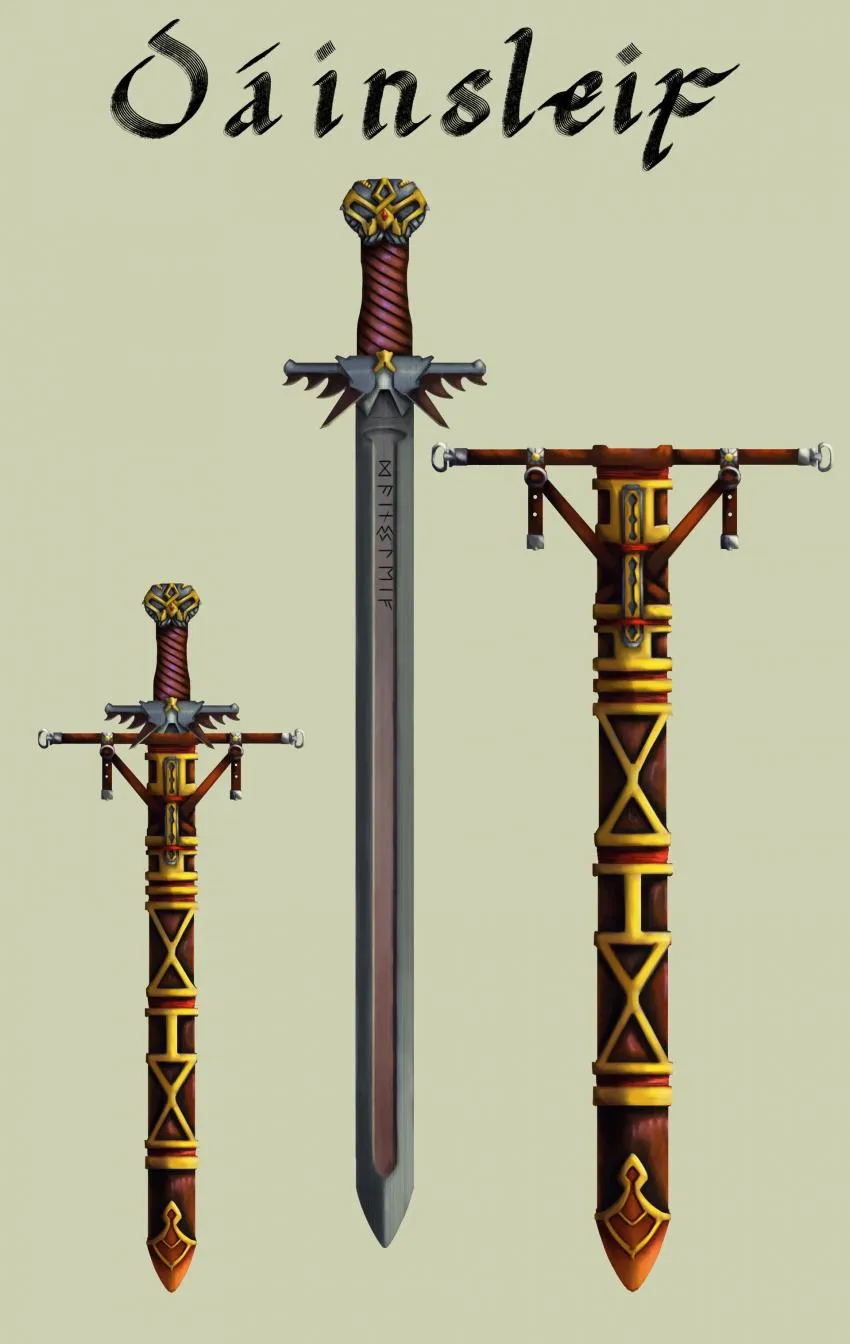
The legendary sword of King Högni, one of Norse’s great heroes. The name means 'Dain’s legacy' in Old Norse and was crafted by the renowned dwarf Dain. Dain ingrained magic into Dáinsleif, so when it is drawn it can not be sheathed again until it has killed someone, not something you would idly want to show off at feasts.
The magic also means that you don’t have to be a skilled swordsman to wield Dáinsleif, as it is impossible for the sword not to hit its intended target. Once it does strike, even the smallest cut will prove fatal, inflicting wounds that will never heal. Basically, it’s best to never go up against King Högni while he has Dáinsleif by his side.
Apparently, another King, Heðinn Hjaarandason, didn’t get this message as he kidnapped Högni’s daughter, Hild, managing to take her far away before the King noticed. (What kind of parenting is that?) Högni chased Hedin to the North and West before finally catching up with him and drawing his sword; by this time, his daughter Hild had decided she was okay with being kidnapped and implored her father to make peace with Heðinn.
However, King Högni could not forgive Heðinn for tricking him (seems more like negligent parenting to me…) and said it was too late to stop it as Dáinsleif had been drawn and needed blood to satisfy it. So the two sides went to war.
At night when both sides had retreated, Hild resurrected the dead soldiers; the next day though, Högni and Heðinn carried on fighting, continuing to use the reanimated soldiers. Because of this, a loop was created and the kings became stuck in a never-ending battle. At least Dáinsleif would never go hungry, right?
2. Lævateinn: Wand of Loki
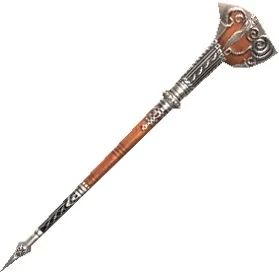
Lævateinn is an interesting weapon but a bit of a confusing one too, which seems appropriate considering it was created by Loki who is famous for his mischievous deeds-even the beginning of the name ‘læ’ means ‘fraud/trickery.’
The Lævateinn has been theorised to be a wand, or sword, or even a dart by different translators over the years, but it is unclear which is correct. Although Lævateinn can be literally translated as ‘wand-of-destruction’ or ‘damaging wand,’ it has also been said that these could just be kennings (poetic phrases) for a sword. (Loki really couldn’t make it easy for them.)
If it's not a sword, don’t go thinking it’s some dainty little wand like you see in Harry Potter, think more the height of a grown man, like Gandalf’s staff in The Lord of the Rings. Norse Gods don’t go round waving twigs, thank you very much.
Lævateinn is needed so that the rooster Viðofnir, a mythological bird (often depicted as a falcon) who sits at the top of the world tree Mímameiðr can be slain and the seeker can succeed in their quest-or so it is said in the poem Fjölsvinnsmál from the Poetic Edda.
It’s not totally clear why Viðofnir has to die though, I know roosters make a lot of noise but still, a bit harsh. When Lævateinn isn’t being used to kill mythical poultry, it is locked up in Hel, not the nicest place to be, but then Lævateinn is just a wand (or sword) so it probably doesn’t care.
3. Skofnung: Sword of Hrólf Kraki
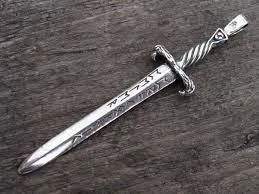
Skofnung is the sword of legendary Danish king Hrólf Kraki and was supposedly deemed the best of all the swords in the lands of the north. Supernaturally sharp and hard, the souls of twelve berserkers who were faithful to Hrólf Kraki are bound to the blade increasing its power.
It is so powerful in fact, that it cannot be drawn if women are present, and its hilt must never come into contact with the sun’s rays. Similar to Dáinsleif, the wounds inflicted by Skofnung won’t heal; however, unlike Dain’s legacy, there is an object that acts as an antidote. If a wound caused by Skofnung is rubbed with the Skofnung Stone it will heal, and the victim will be cured.
Skofnung goes on quite the journey in Norse Mythology, it starts off with Hrólf Kraki and when he dies Skofnung is buried with him. However, it didn’t stay buried for long as the Icelandic warrior Midfjardar-Skeggi or Skeggi of Midfirth robs the burial mound, taking Skofnung with him. Skeggi hands the sword down to his son Eid of Ás who lends it to his kinsman Thorkel Eyjólfsson so that he can kill an outlaw called Grim who had killed Eid’s son.
However, after fighting Grim, Thorkel befriended him and never returned the sword to Eid. Basically, he stole it, which seems a bit harsh-never lend Thorkel books, it sounds like he won’t return them. Thorkel kind of gets his just-desserts as when he is sailing his ship capsizes and he and his crew drown (I mean that’s probably a crueller punishment than he deserved, really).
Luckily, Skofnung gets stuck in some wood of the ship and ends up washing ashore. From there it is somehow recovered by Thorkel’s son Gellir and when he dies Skofnung is buried with him. Apparently, Gellir was buried near to where Hrólf Kraki’s burial mound was located, so Skofnung kind of comes full circle and once it is buried (again) Skofnung isn’t recovered.
4. Gram: Sword of Sigurd
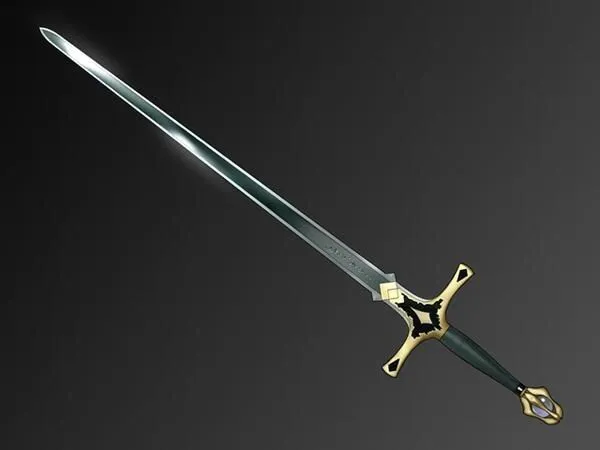
Gram from the Old Norse ‘Gramr’ which means ‘wrath’ is the sword of Sigurd, who is essentially the Norse equivalent of Hercules. There isn’t a lot of description regarding Gram’s appearance, but it is said to gleam with a bright light and be covered in gold (quite the statement piece). Gram was originally given to Sigmund, Sigurd’s father, by Odin in a round-about Arthurian Excalibur-esque fashion.
Sigmund was at a wedding feast for his sister Signy who was marrying king Siggeir in a hall, at the centre of which grew a tree called Barnstokkr. In the middle of the celebration, a stranger carrying a sword intruded, thrusting it into Barnstokkr. He proclaimed that: ‘the man to pull out this sword from the trunk shall receive it from me as a gift and he will find out for himself that he never bore in hand a better sword than this,’ then left (as you do).
After the stranger left all the men had a go at pulling the sword free of the wood, all failed except for Sigmund who lifted it out easily. Because Gram was such a fine sword, king Siggeir tried to buy it from Sigmund but Sigmund refused, after that Siggeir dropped the niceties and he murdered Sigmund’s father, captured his brothers, and Sigmund himself. Just as Sigmund was being buried alive, his sister returned Gram to him, and he immediately used it to avenge his family.
Sigmund continued to use Gram in a number of battles until it was eventually broken by Odin in his final battle. Odin sided with Sigmund’s opponent, King Lyngvi, and broke Gram at a crucial moment, allowing Sigmund to be mortally wounded. What’s up with that Odin? Later Sigmund’s wife Hjördis collected the two halves of the sword, keeping them to give to Sigmund’s son Sigurd.
Sigurd acquires Gram when he is tasked with killing the dragon Fafnir by the Dwarven blacksmith Regin. Sigurd agrees to kill Fafnir on the condition that Regin makes him a mighty sword with which to do it. Regin makes two good swords, but Sigurd breaks each on an anvil.
On Regin’s third attempt, Sigurd brings him the two halves of Gram that his mother had saved for him, this time it was the anvil that broke. Sigurd not only slays Fafnir in one stroke, but he also goes on to avenge his father and accomplish many other feats with Gram. Gram is eventually placed on Sigurd and Brynhild’s funeral pyre.
5. Shoes of Víðarr
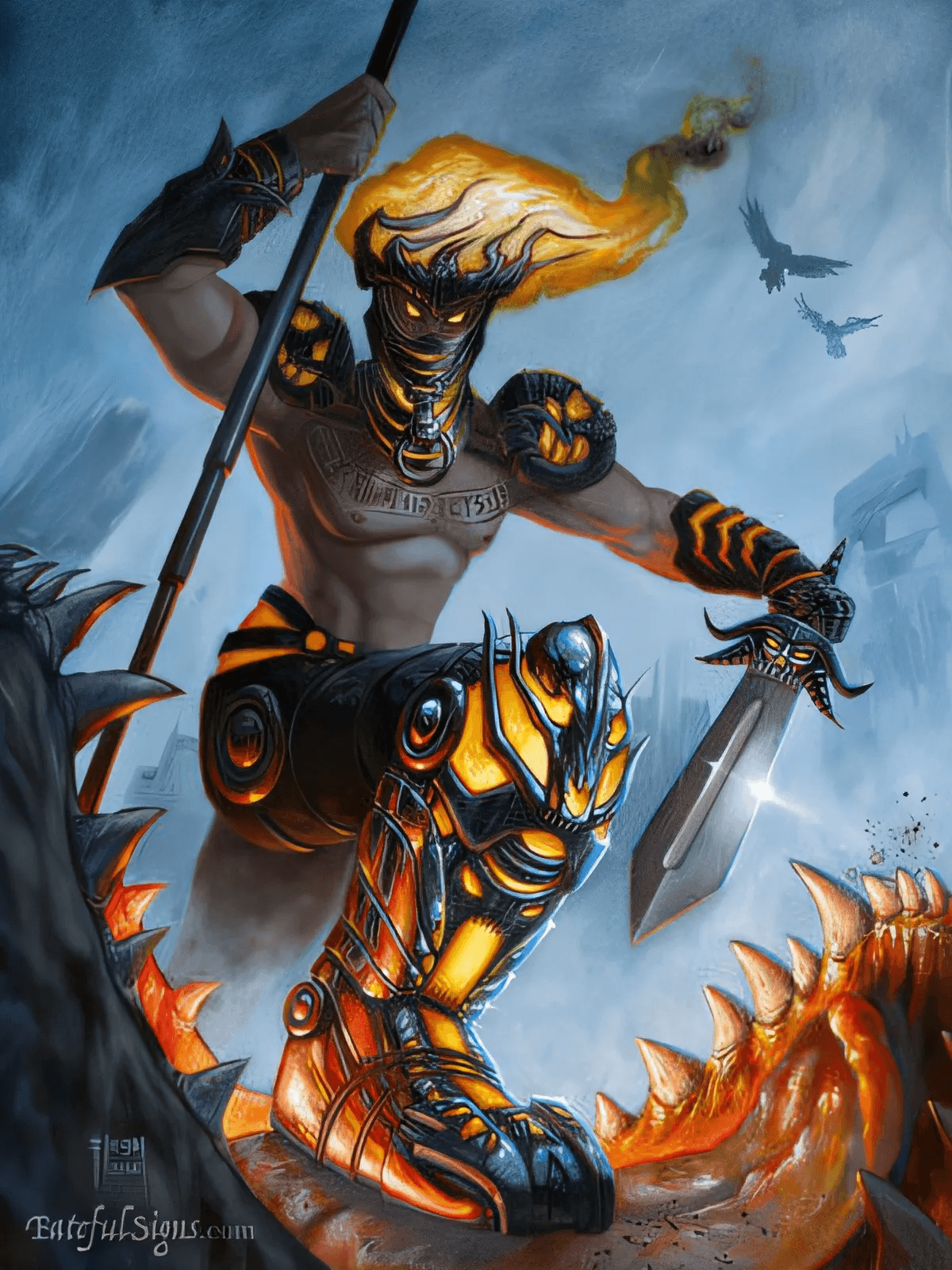
Víðarr or Vidar is the son of Odin and Gríðr, a jötunn giantess, he is one of the Æsir Gods and is associated with a vengeance. He is a god from the younger generation and one who survives Ragnarok. He is characterised as being silent and at peace with nature, wielding strength nearly as strong as Thor’s.
Being close to nature, Vidar spends most of his time in his garden working on his shoes, which are made of all the strips of leather that get thrown away by the shoemakers of Midgard when they make new shoes. Vidar's shoes are made for one specific purpose and that is to help him fulfil his role in Ragnarok.
The sturdiness of his shoes, which may also be imbued with magic, though it’s not certain (but I wouldn’t put it past them, they are Norse gods after all), allow him to prise the jaws of the wolf Fenrir open so that Vidar can slash at the wolf’s mouth with his sword and kill him, avenging his father Odin, who Fenrir has just eaten.
6. Gjallarhorn: Horn of Heimdall
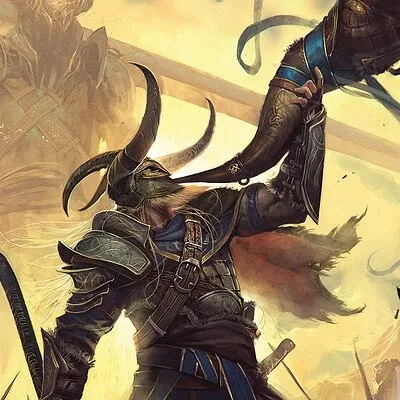
Gjallarhorn, meaning ‘resounding horn’ is one of the Norse gods most prized possessions and as such is kept in the hands of the ever-watchful Heimdall. At the beginning of Ragnarok, Heimdall spots Loki’s armies as they approach Asgard over the Bifrost and gives Gjallarhorn such a mighty blow that he not only alerts the Asgardians, but the whole of the cosmos, so every living thing is aware that the end is approaching.
It is also thought that Gjallarhorn is used as a drinking vessel as well as a musical instrument with both Heimdall and Mimir supposedly drinking from it. I mean why not, if you’ve got it, you may as well, right?
7. Angurvadal: Sword of Frithiof
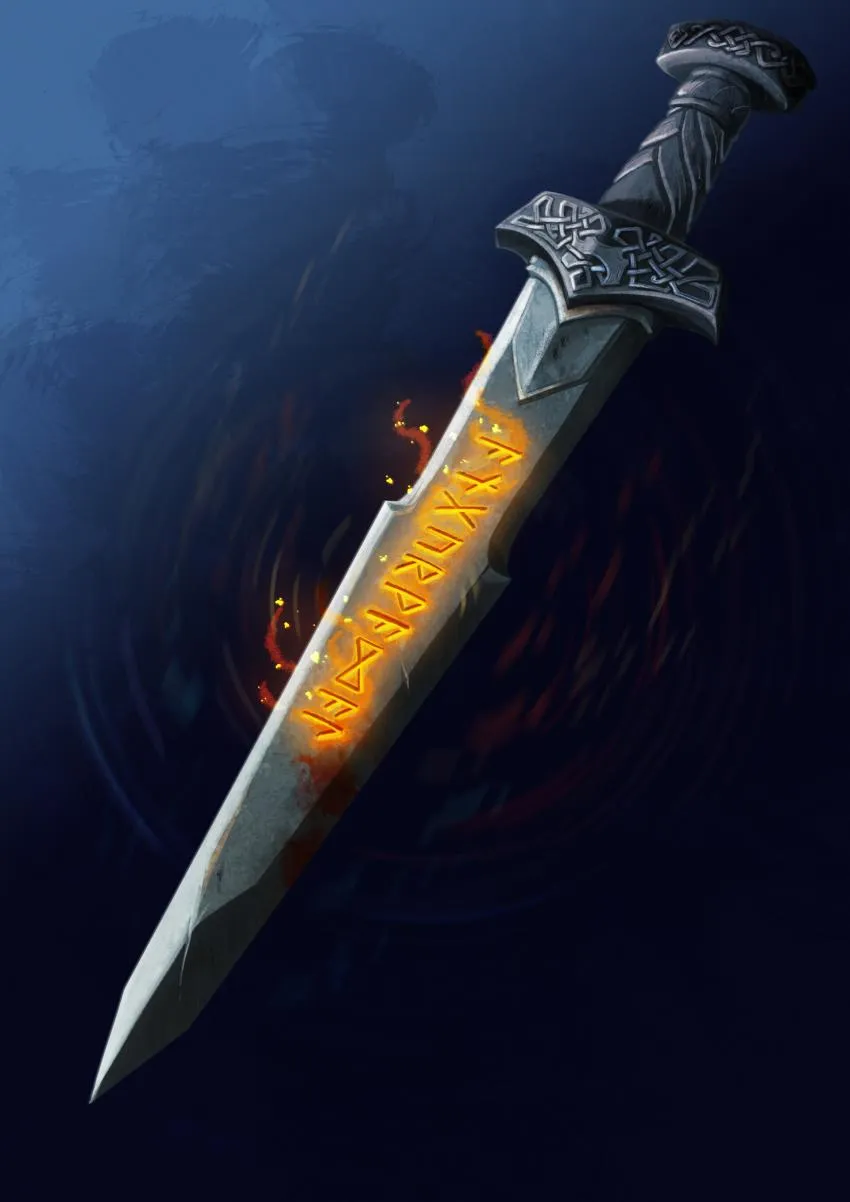
Angurvadal, meaning ‘a stream of anguish’ in Old Norse, is a sword with powerful runes inscribed on it that shine brightly in times of war, but only dimly in times of peace. Angurvadal is the sword of the hero Frithiof, son of Thorsteinn Vikingsson, who uses it on a mission in Orkney before he is set to marry Ingeborg the foster daughter of King Beli of Sign, who rules over the Northern region.
However, the king’s two sons are jealous of Frithiof because of his reputation as being the tallest, strongest, and bravest of men (so many inferiority complexes in mythology, get over it guys, seriously); so, while Frithiof was away on the mission they burned down his homestead, and married their foster sister to the elderly King Ring. With nothing left to return to, Frithiof sets sail with Viking warriors to seek his fortune.
After years of plundering and earning glory in battle, he comes back and sets about getting in King Ring’s good books, and succeeds. Now, if the king was old before he’s really old by the time Frithiof befriends him and he soon dies, but not before naming Frithiof his successor and giving him Ingeborg’s hand in marriage.
As soon as he inherits the king’s power Frithiof sets about waging war on the jealous brothers, getting revenge for the wrongs they committed against him. So all’s well that ends well, I guess?
8. Skíðblaðnir: Ship of Freyr
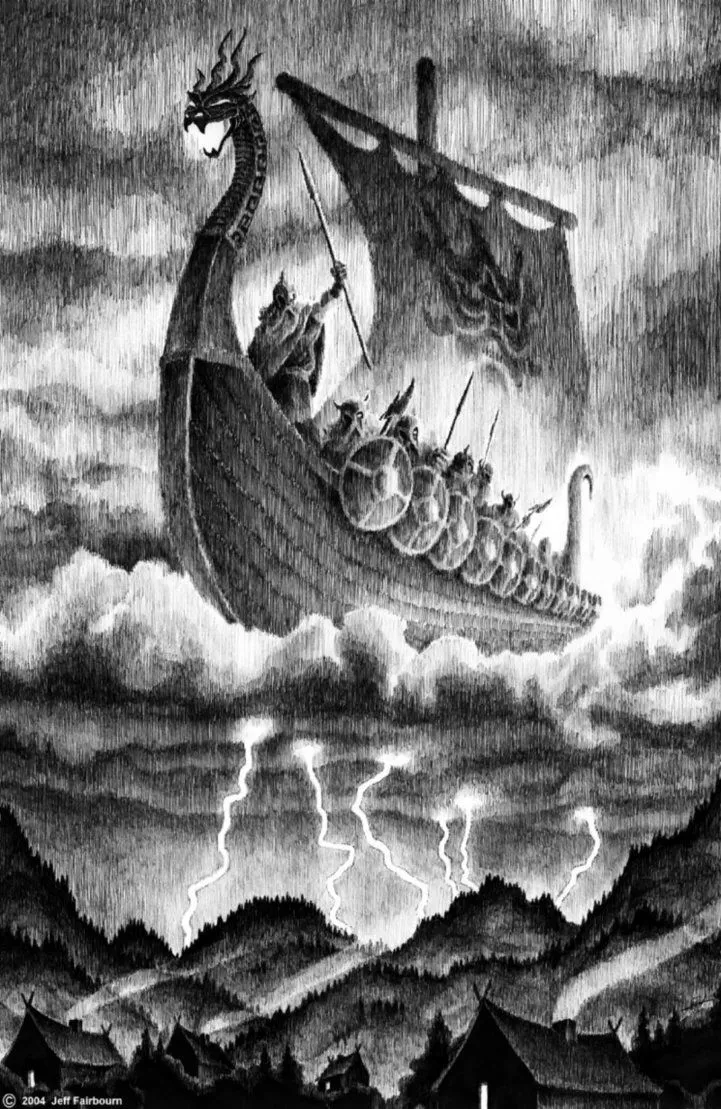
Skíðblaðnir or Skidbladnir, meaning ‘assembled from thin pieces of wood’ in Old Norse, is the finest of all Norse ships and is appropriately named as it is said that the planks are as thin as the blade of a knife. Skidbladnir was made by the dwarves but is acquired by Loki who then proceeds to give the ship to Freyr, the god of fertility, rain, and sunshine.
The ship has magic cast on it that allows it to sail through the air as well as water and ensures that whenever the ship's sails are raised a fair wind will blow. The ship is of such an immense size that it is able to carry all the gods with their armour and all of their weapons (though would you believe it, it’s not the biggest Norse ship to exist, that title belongs to Naglfar, the ship of the dead).
It can also be folded up like a piece of cloth to a size so small it can fit in a pouch and be easily transported over land; Mary Poppins would be proud.
9. Sword of Freyr
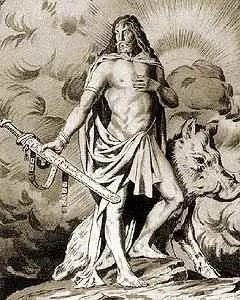
Freyr’s sword doesn’t actually have a name, at least not one that is recorded anyway, making it a bit of a peculiar weapon. It can also move and fight on its own, which may not seem that unusual when talking about myths and legends, but in Norse mythology, there aren’t many weapons capable of moving without a hand guiding them.
So, you’d think that having come into possession of such a unique weapon Freyr would want to keep it, but he doesn’t, and this decision turns out to be a big mistake. After Freyr and his sister Freyja become associated with the Æsir he decides that he wants to marry the jötunn giantess Gerðr, but to win her heart he has to give up his weapon and stop fighting.
Freyr gives his sword to his vassal Skírnir and essentially lives happily with his wife, only getting into the odd skirmish every now and then, luckily, he is able to win the fights using a giant antler. Unfortunately, the antler isn’t enough when Ragnarök comes around and he has to battle the jötunn Surtr, who fights with a flaming sword.
There are some theories that argue that the sword Surtr uses to kill Freyr is his own sword that he had previously given up for Gerðr, which would be tragically ironic, but it’s uncertain (as are a lot of things in mythology, you just have to deal with it).
10. Gleipnir: Chain of Fenrir
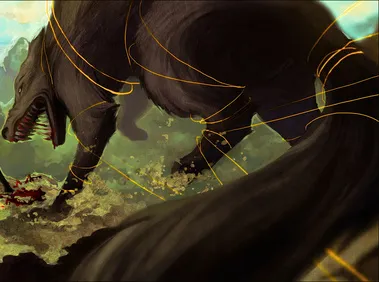
Gleipnir is the enchanted ribbon that is specifically made to restrain the giant wolf Fenrir, Loki’s son; ironically, Gleipnir translates to ‘open one’ in Old Norse. The gods were afraid of Fenrir’s strength and potential to wreak havoc, so they tricked him into letting them chain him up under the guise of seeing how strong he was.
They used the strongest chains they could find but he broke them all; so, they commissioned the dwarves to make a chain strong enough to bind him. The dwarves made Gleipnir out of six impossible items: the sound of a cat’s footstep, the breath of a fish, the sinews of a bear, the saliva of a bird, the roots of a mountain, and the beard of a woman. Because Gleipnir was made of impossible things, it was impossible to break.
The dwarves’ finished product was as thin as a silk ribbon but stronger than any iron chain. The Asgardians eagerly took it to Fenrir but by this time the wolf had wised up and when he saw the chain, he was very suspicious, saying he would only put it on if one of the Asgardians put their arm in his mouth. Fenrir stated that if he couldn’t break the chain and the Asgardians didn’t take it off for him, he would bite the arm off of whoever volunteered.
Despite knowing what was going to happen, a god named Tyr volunteered and put his arm in Fenrir's jaws. Fenrir was unable to break the chains and when they weren’t removed, he bit Tyr’s arm off. The chains bound Fenrir until Ragnarök when he broke free killing many Asgardians, including Odin, and honestly, I don’t blame him for holding a grudge.
11. Hǫfuð: Sword of Heimdall
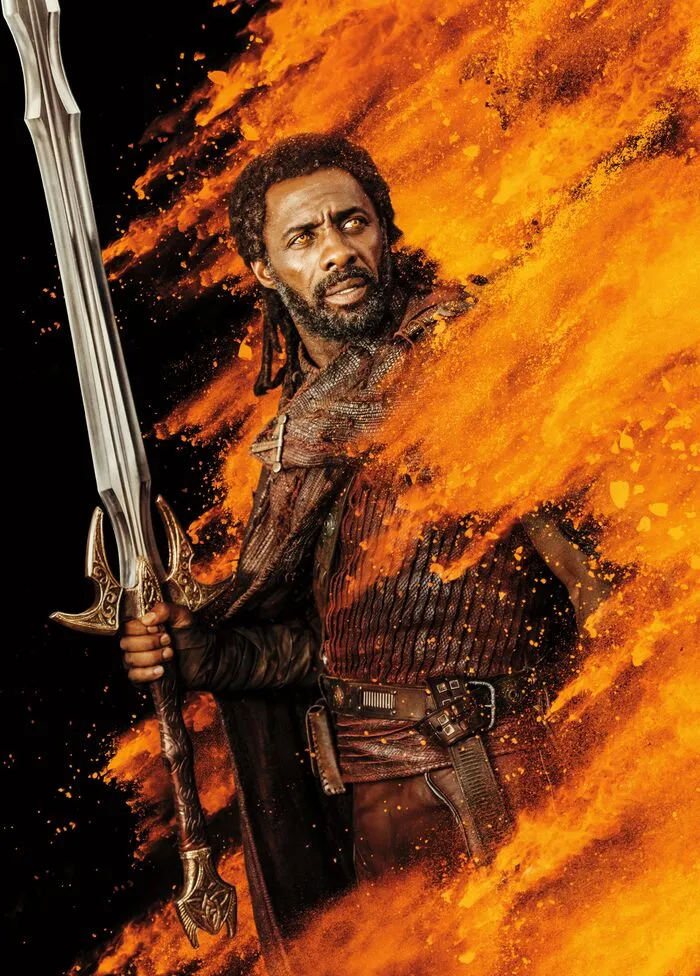
Hǫfuð or Hofund, meaning ‘man-head,’ is the sword wielded by Heimdall the eternal watcher and guardian of the Bifrost-the way in and out of Asgard. Heimdall has the ability to see what is happening in all of the Nine Realms and his sword reflects this power.
Heimdall can use Hǫfuð to draw on the energies across the Nine Realms to greatly increase its power to help him in times of crisis. Despite the fact that Heimdall is not usually a frontline fighter, he is front and centre during Ragnarök, using Hǫfuð to battle both Surtr and Loki-managing to kill Loki in a fight that was fatal for both of them.
12. Gungnir: Spear of Odin
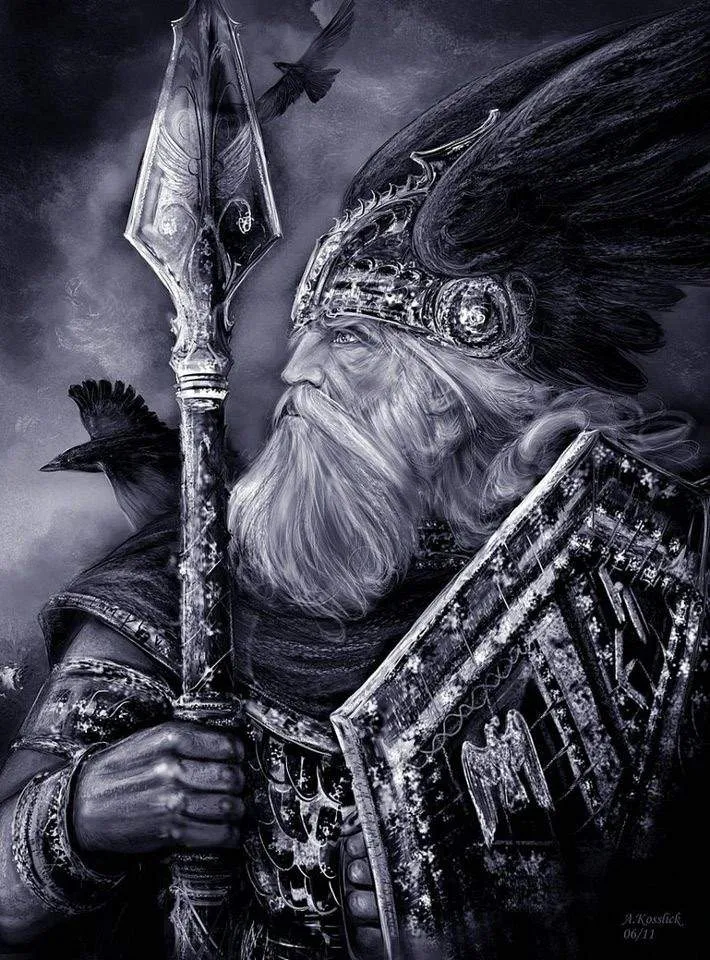
Gungnir is the spear wielded by Odin the All-father and King of the Asgardians, its name means ‘the swaying one’ and it is so perfectly balanced that it will never miss its target. It also has runes carved into the tip granting the user great strength and accuracy. It is said that oaths sworn on the spear cannot be broken.
Although it's Odin’s weapon of choice, Gungnir was actually commissioned by Loki who asked the sons of the dwarf Ivaldi to make it after requesting a golden wig be made to replace the lost hair of the goddess Sif. In another version of Gungnir’s origin, the dwarves forged Gungnir especially for Odin from sunlight.
Odin wields Gungnir in many battles and is thought to use it to begin the war between the Æsir and Vanir as it is recorded that Odin throws his spear over the heads of the Vanir gods just before the fighting commences, though it is not specified that Gungnir is the spear thrown. Odin also uses Gungnir in the final battle of Ragnarök, but unfortunately, it is not enough as he is ultimately eaten by Fenrir.
13. Mjolnir: Hammer of Thor
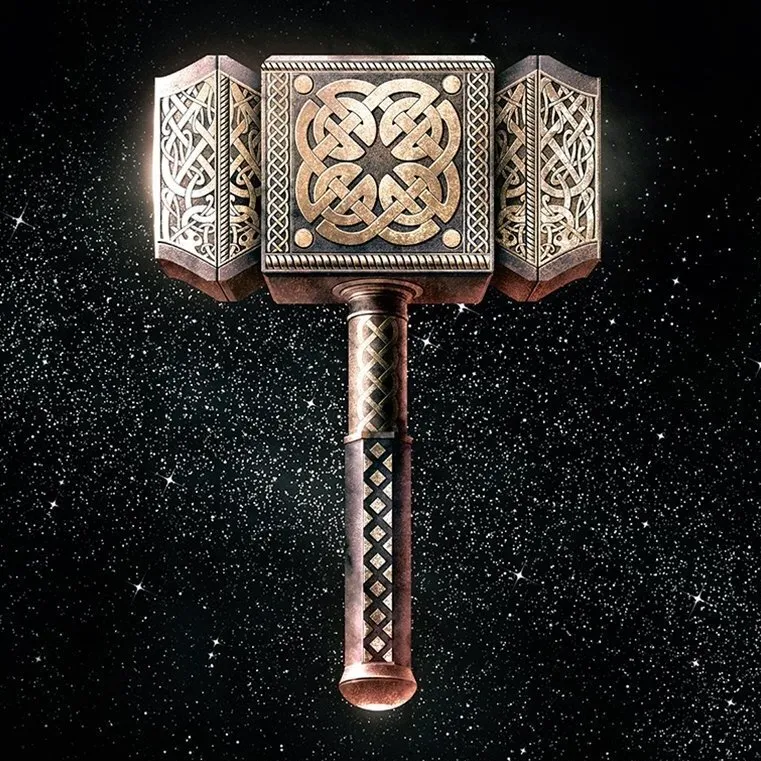
Probably the most famous weapon in Norse Mythology (no doubt in part due to Chris Hemsworth and Marvel), Mjolnir is the war hammer wielded by Thor the god of Thunder. It’s one of the mightiest weapons in Norse mythology with enough power to level mountains and summon thunderstorms, so it’s fitting that its name means ‘crusher’ or ‘grinder.’
Like Gungnir, Mjolnir was made at the request of the infamous god of mischief, Loki. Loki had travelled to Svartalfheim, the land of the dwarves, in order to find a replacement for the hair he had cut off of Thor’s wife Sif, for this he commissioned the sons of Ivaldi-who also made Gungnir and the ship Skidbladnir.
While the dwarves were working on the hair, Loki challenges two other dwarf brothers Brokkr and Sindri to make three more items, promising to let the dwarves have his head if they succeed. Brokkr and Sindri make a boar with golden hair called Gullinbursti, a magic ring called Draupnir, and of course, the war hammer Mjolnir. As the dwarves are making Mojlnir though, Loki can’t help but try to mess with them (obviously), and he shapeshifts into a fly to try and cause them to make a mistake.
Although the dwarves fight off his interference admirably, they do end up making a mistake as they accidentally make the handle of Mojlnir a bit short. Luckily, this isn’t a problem for Thor.
Once completed, Loki steals the treasures and presents them to the other gods. When Brokkr and Sindri arrive in Asgard asking for Loki’s head, Loki wheedles his way out of it by claiming that he promised them his head but not the neck it’s attached to, so Brokkr and Sindri just settle for sewing his mouth shut. A pretty cruel-but deserved punishment for Loki who relies on his quick tongue. I'd like to say that he learns from it, but he doesn't.
I think the main thing that can be learned from this list is that Norse weapons are not to be trifled with, I certainly wouldn’t want to be on the wrong end of one. Secondly, that Norse dwarves are extremely skilled and should be getting a lot more business and respect, not being scammed by a god of mischief-especially when they don’t even get to keep his head.
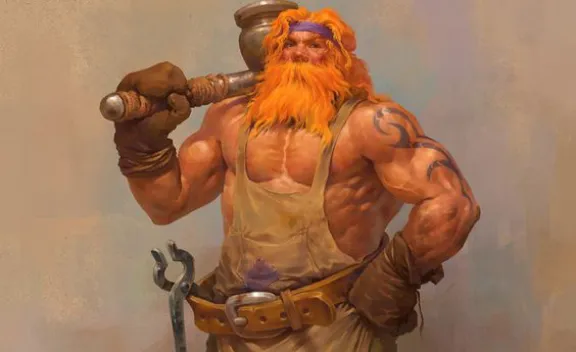
Opinions and Perspectives
Its fascinating how many of these weapons require sacrifice to use. Really drives home the Norse view of power and cost
The whole Mjolnir creation story is peak Norse mythology. Even their crafting tales are epic
I love that Loki gets his mouth sewn shut for being too clever. Classic trickster comeuppance
Anyone else notice how many of these weapons are connected to oaths and promises? Really shows the Norse values
The way these weapons impact their wielders' fates is really thought-provoking
Its interesting that most of these weapons were made by dwarves but used by gods. Says a lot about power dynamics
The Norse really knew how to tell a story. Even their weapons have complex character arcs
Reading about these makes modern fantasy weapons seem pretty tame in comparison
What impresses me most is how these weapons fit into larger narratives. They're not just plot devices
The Norse really understood that great power comes with great consequences. None of these weapons are simple to use
These weapons seem more like forces of nature than tools. Each one has the power to reshape the world
The level of detail in these weapon histories is amazing. Even minor weapons have complete backstories
Kind of ironic that Loki commissioned so many of these weapons that ended up being used against him
Reading about Gleipnir makes me appreciate Norse creativity. Who thinks to make a chain out of impossible things?
I appreciate how each weapon has its own personality and quirks. They're not just interchangeable magic items
The way these weapons keep changing hands throughout the stories makes them feel like characters in their own right
These weapons really show the Norse appreciation for craftsmanship. Even their magical items needed to be well-made
Someone needs to make a video game where you can collect all these weapons. The mechanics would be incredible
I'm struck by how many of these weapons are swords. Makes you wonder what other types of weapons got left out of the stories
The fact that Vidar's shoes are made from discarded leather scraps is such a cool detail. Waste not, want not
No wonder the Vikings were so feared if these were the kinds of weapons they told stories about
It's wild how many of these weapons are specifically designed to kill gods or monsters at Ragnarök
I love how Norse weapons don't just kill, they have specific ways of killing that make them unique
That story about Hild resurrecting dead soldiers every night is hardcore. Talk about commitment to keeping a fight going
The description of Gram gleaming with bright light makes me wonder if Tolkien drew inspiration from it for Sting and Glamdring
When you think about it, most of these weapons are cursed in some way. They all come with serious drawbacks
Poor Tyr. Everyone remembers his sacrifice but forgets he was essentially tricked into it
Anyone else notice how many of these weapons are connected to Ragnarök? They're like Chekhov's guns on a cosmic scale
The dwarves really deserve more credit. They made most of these legendary weapons and barely got anything in return
I find it fascinating that so many of these weapons have personalities or wills of their own
Interesting how many of these weapons end up on funeral pyres or in burial mounds. Seems like they wanted to keep them out of circulation
Love how specific the rules are for these weapons. Can't draw it around women, must kill when unsheathed, needs blood sacrifice
The fact that Dáinsleif requires zero skill to use effectively is both terrifying and fascinating
I'm surprised more fantasy games haven't borrowed from these weapon concepts. They're perfectly built for epic quests
Kind of poetic how Heimdall and Loki kill each other in Ragnarök, considering how often they opposed each other
The way Loki keeps showing up in all these origin stories really shows how central he was to Norse mythology
These weapons remind me why Norse mythology is so epic. Even their regular items have complex backstories and dire consequences
I wonder if Marvel knew about all these other weapons when they chose to focus on Mjolnir. Some of these others seem way cooler
The whole concept of weapons that can't be sheathed until they draw blood is terrifying. Imagine accidentally pulling it out at the wrong moment
Did anyone catch that bit about Hǫfuð drawing power from all Nine Realms? That's some serious magical networking
Anyone else think it's weird that Freyr's sword doesn't even have a name? Seems odd for such a powerful weapon
I respectfully disagree about Gungnir being more impressive than Mjolnir. Mountain-leveling power beats accuracy any day
Skíðblaðnir sounds like the ancient Norse version of a Swiss Army knife. A ship you can fold up and put in your pocket is pretty convenient
The way these weapons each have specific rules and limitations makes them feel more real somehow. Not just all-powerful magic items
Reading about Angurvadal makes me think about how practical it would be. Like a built-in threat detector with those glowing runes
Man, Tyr putting his arm in Fenrir's mouth knowing he'd lose it takes some serious courage
The never-ending battle between Högni and Heðinn is such a powerful story. Imagine fighting forever because you can't sheathe your sword
I never realized how many of these weapons came from dwarves. They're like the master weaponsmiths of Norse mythology
Everyone talks about Mjolnir but honestly Gungnir seems more impressive. A spear that never misses and can seal unbreakable oaths? Sign me up
The dwarves really got shortchanged in that deal with Loki. They should have known better than to make bets with the god of mischief
Thor's hammer having a short handle because Loki couldn't help being annoying is peak Loki behavior
The materials used to make Gleipnir are genius. The impossible items remind me of riddles. Love how the dwarves thought outside the box
I find it interesting that Freyr gave up his self-fighting sword for love. Not sure I'd make that trade knowing Ragnarök was coming
The description of Gjallarhorn is amazing. Imagine a horn blast so powerful it alerts the entire cosmos. That's metal
Vidar's shoes might seem less impressive than the other weapons, but I find it incredible that something made from discarded leather scraps could help kill Fenrir
You raise a good point about Excalibur. Many Norse myths actually influenced later medieval stories, including Arthurian legends
I can't be the only one who sees parallels between Excalibur and Gram? The whole sword-in-tree thing seems too similar to be coincidence
The way Odin gives out weapons and then sometimes turns against the wielders is pretty messed up. Look what he did to Sigmund with Gram
Actually, the restriction about women and sunlight with Skofnung probably has deeper cultural significance. I've studied Norse mythology and these limitations often represent important social taboos
I think my favorite has to be Skofnung. The fact that it can't be drawn around women and needs to avoid sunlight makes it seem more like a vampire than a sword
Lævateinn sounds fascinating but I'm a bit confused about why they'd need such a powerful weapon just to kill a rooster. There must be more to that story than we know
The thing about King Högni's poor parenting really made me laugh. I mean, how do you not notice your daughter being kidnapped?
I love how Norse mythology is finally getting the attention it deserves. The weapons are just incredible, especially Dáinsleif with its never-healing wounds. Makes me wonder why it took so long for these stories to become mainstream
